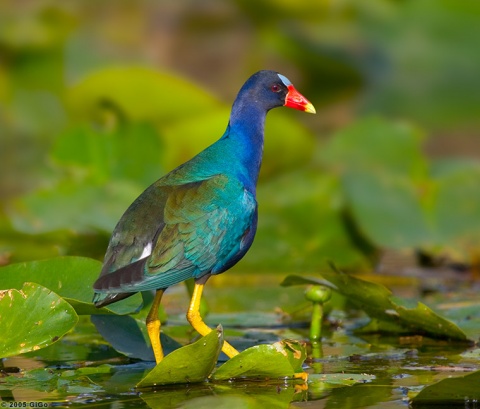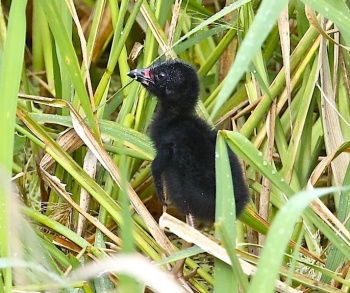Disambiguation: For the species Porphyrio porphyrio, formerly often called Purple Gallinule, see Western Swamphen
Alternative names: American Purple Gallinule, Yellow-legged Gallinule
- Porphyrio martinica
Porphyrula martinica
Identification
Length 27-36 cm (10½-14¼ in), wingspan 50-55 cm, weight 140-300 g
Red bill with yellow tip, head and underparts deep violet-purple, back bronzy green, pale blue forehead shield, and white band on the flanks. The legs are yellow, very conspicuous in flight.
Immatures are drab brown, dark above and pale below; no side stripe; dark bill.
Distribution
Southeastern USA to northern Argentina; also found in the West Indies.
Taxonomy
This is a monotypic species[1].
The South Georgia Gallinule, once described as an independent species Porphyrula georgica, was later shown to just be an aberrant Purple Gallinule, and as such is an invalid taxon, now considered synonymous with Porphyrio martinica3.
Habitat
Lives in freshwater swamps, marshes, and ponds.
Behaviour
Swims, wades, and climbs bushes. When walking, it flirts white undertail coverts; when swimming, pumps head.
Diet
Their diet mostly consists of a variety of plants, such as sedges, cheickweed, water lilies, willow, fruit, grass and sedge seeds.
Vocalisation
Call: a henlike cackling "kek, kek, kek" given while flying; also guttural notes.
References
- Clements, J. F., T. S. Schulenberg, M. J. Iliff, D. Roberson, T. A. Fredericks, B. L. Sullivan, and C. L. Wood. 2017. The eBird/Clements checklist of birds of the world: v2017, with updates to August 2017. Downloaded from http://www.birds.cornell.edu/clementschecklist/download/
- Avibase
- Meyer de Schauensee, Rodolphe. 1966. The Species of Birds of South America and Their Distribution. Narberth, PA: Academy of Natural Sciences.
- Handbook of the Birds of the World Alive (retrieved August 2016)
Recommended Citation
- BirdForum Opus contributors. (2024) Purple Gallinule. In: BirdForum, the forum for wild birds and birding. Retrieved 16 April 2024 from https://www.birdforum.net/opus/Purple_Gallinule






